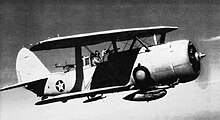
Marine Attack Squadron 231 (VMA-231) is a United States Marine Corps fixed wing attack squadron that consists of AV-8B Harrier (V/STOL) jets. The squadron, known as the "Ace of Spades", is based at Marine Corps Air Station Cherry Point, North Carolina and fall under the command of Marine Aircraft Group 14 (MAG-14) and the 2nd Marine Aircraft Wing.
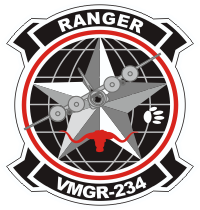
Marine Aerial Refueler Transport Squadron 234 (VMGR-234) is a reserve United States Marine Corps KC-130J squadron. They are a part of Marine Aircraft Group 41 (MAG-41), 4th Marine Aircraft Wing and provide both fixed-wing and rotary-wing aerial refueling capabilities to support Marine Forces Reserve air operations in addition to assault air transport of personnel, equipment, and supplies. The squadron, known as the "Rangers" is stationed at Naval Air Station Joint Reserve Base Fort Worth, Texas.
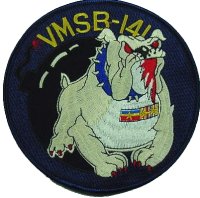
Marine Attack Squadron 141 (VMA-141) was a reserve fighter squadron in the United States Marine Corps. The squadron fought as part of the Cactus Air Force during the Battle of Guadalcanal in World War II and they also saw service during the Korean War. While with the reserves, they operated out of the San Francisco Bay Area until their deactivation on 1 September 1969.
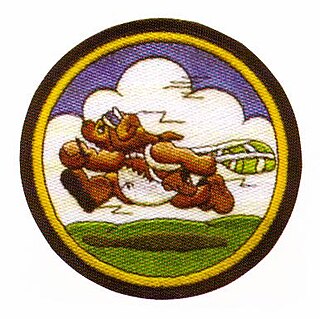
Marine Fighting Squadron 155 (VMF-155) was a fighter squadron of the United States Marine Corps in World War II. During the war, they flew the SBC Helldiver and, after reconstitution in 1943, the F4F Wildcat. Later in the War the squadron also flew the F4U Corsair. One of the squadron's pilots who went on to great distinction later in his career was Lieutenant John Glenn. The squadron, also known as "Ready Teddy" was deactivated shortly after the war and is still inactive.
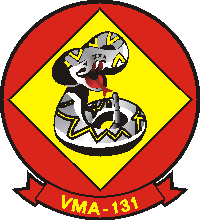
Marine Attack Squadron 131 (VMA-131) was an A-4 Skyhawk attack squadron in the United States Marine Corps. The squadron, also known as the "Diamondbacks", were part of the Marine Forces Reserve and were based at Naval Air Station New York, Brooklyn, New York from 1960 through 1970 and NASJRB Willow Grove from 1971 until their deactivation in 1998.

Marine Attack Squadron 133 (VMA-133) was a reserve A-4 Skyhawk fighter squadron in the United States Marine Corps. Originally known as VMSB-133, the squadron saw combat during the World War II campaigns on Bougainville and Philippines. Following the war they became part of the Marine Forces Reserve. The squadron, also known as the "Dragons", was part of Marine Aircraft Group 42 of the 4th Marine Aircraft Wing and was based out of Naval Air Station Alameda, California. They were deactivated in 1992 as part of the post Cold War drawdown of the U.S. Military.

Marine Aviation Training Support Group 22 (MATSG-22) is a United States Marine Corps aviation training group that was originally established during World War II as Marine Aircraft Group 22 (MAG-22). Squadrons from MAG-22, were decimated at the Battle of Midway and, after reconstituting, fought during the Battle of Okinawa. The group was deactivated following the end of the war and was not reactivated until May 1, 2000, when the Marine Aviation Detachment at Naval Air Station Corpus Christi, Texas was renamed MATSG-22.
Marine Aircraft Group 93 (MAG-93) was a United States Marine Corps aviation group established during World War II. MAG-93, a dive bombing training group, was commissioned on 1 April 1944 and was initially headquartered at Marine Corps Auxiliary Airfield Bogue, North Carolina. Their mission was to train pilots to fly the Curtiss SB2C Helldiver. The group was decommissioned in October 1945 as part of the post-war drawdown of forces and has been inactive since.

Marine Fighting Squadron 132 (VMF-132) was a fighter squadron in the United States Marine Corps. The squadron, also known as "The Crying Red Asses", fought in World War II as a dive bomber unit during the Battle of Guadalcanal as part of the Cactus Air Force and later fought in the Central Solomon Islands. The squadron was decommissioned shortly after the end of the war but was reactivated in the Marine Air Reserve flying out of Floyd Bennett Field in Brooklyn, New York. They were again decommissioned sometime after 1958.

Marine Attack Squadron 144 (VMA-144) was a reserve Douglas A-4 Skyhawk attack squadron in the United States Marine Corps. Originally known as VMSB-144, the squadron saw its first combat in World War II as part of the Cactus Air Force during the Battle of Guadalcanal and also provided close air support during the Bougainville campaign (1943-1945). Following the war the squadron was deactivated but later became part of the Marine Air Reserve and was based out of Naval Air Station Jacksonville and then Naval Air Station Cecil Field, Florida.

Marine Scout Bombing Squadron 243 (VMSB-243) was a dive bomber squadron in the United States Marine Corps. The squadron, also known as the “Flying Goldbricks”, fought in World War II during the Battle of Bougainville and later in the Philippines campaign (1944–45). They were deactivated shortly after the end of the war on September 25, 1945.

Marine Scout Bombing Squadron 245 (VMSB-245) was a dive bomber squadron in the United States Marine Corps during World War II. The squadron, also known as the “Red Mousie Squadron”, operated from Midway and Makin Atolls, Majuro and Ulithi while overseas. The squadron was decommissioned on November 17, 1945, shortly after the end of the war.
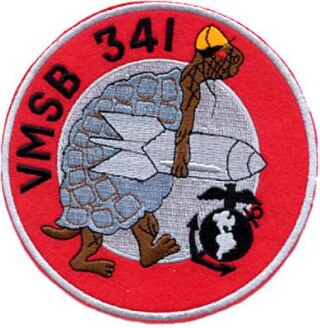
Marine Scout-Bomber Squadron 341 (VMSB-341) was a dive bomber squadron in the United States Marine Corps. The squadron, also known as the “Torrid Turtles”, fought in World War II with Marine Aircraft Group 24, most notably in the Philippines campaign (1944–45). They were deactivated shortly after the end of the war on September 13, 1945.

Marine Attack Squadron 233 (VMA-233) was an A-4 Skyhawk attack squadron in the United States Marine Corps. The squadron, also known as the "Flying Deadheads", were part of the Marine Forces Reserve and were based at Naval Air Station Norfolk, Virginia until their decommissioning in 1969. Originally activated during World War II, they fought in many areas of the Pacific War including the Battle of Guadalcanal as part of the Cactus Air Force, the Battle of Okinawa and the Battle of Balikpapan (1945). They were the only Marine Corps squadron to have three commanding officers killed during the course of the war and were credited with downing 8 Japanese aircraft. Following the surrender of Japan, the squadron was decommissioned on 10 March 1946. They were reactivated as part of the Reserves but were again decommissioned in 1969.

Marine Scout Bombing Squadron 244 (VMSB-244) was a dive bomber squadron in the United States Marine Corps. The squadron, also known as the “Bombing Banshees”, fought in World War II in the Pacific Theater as part of the 1st Marine Aircraft Wing. They were deactivated shortly after the end of the war.
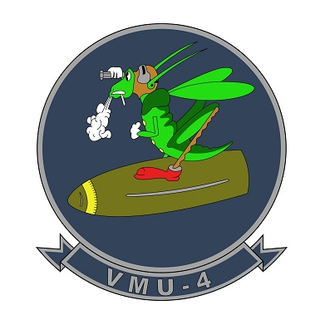
Marine Unmanned Aerial Vehicle Squadron 4 (VMU-4) is an unmanned aerial vehicle (UAV) squadron in the United States Marine Corps that operates the RQ-21 Blackjack. It is the fourth UAV squadron in the Marine Corps and the first in the reserve component. The squadron, nicknamed the "Evil Eyes", entered the force structure on 1 July 2010, when Marine Observation Squadron 4 (VMO-4) was reactivated and redesignated VMU-4.
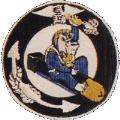
Marine Attack Squadron 143 (VMA-143), nicknamed the Rocket Raiders, was a reserve attack squadron in the United States Marine Corps. Originally commissioned during World War II, the squadron fought at the Guadalcanal, New Georgia, the Battle of Bougainville, Battle of Okinawa, and the Battle of Balikpapan.
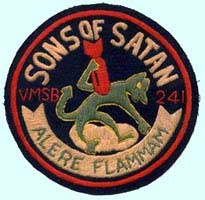
Marine Attack Squadron 241 (VMA-241) was an aircraft squadron of the United States Marine Corps, known as the "Sons of Satan". The squadron was commissioned during World War II and took part in the Battle of Midway, sustaining 75% losses. It was extensively involved in combat while providing close air support during the 1944–1945 Philippines Campaign. The squadron, equipped with A-4 Skyhawk light attack aircraft, became part of the Marine Forces Reserve, based at Naval Air Station Los Alamitos, California, from 1946 until the 1960s.

Marine Scout Bombing Squadron 343 (VMSB-343) was a dive bomber squadron of the United States Marine Corps. Nicknamed “Gregory's Gorilla's”, they were active during World War II but saw limited action due to being assigned to fly anti-submarine patrols from Midway Atoll for their only deployed tour. The squadron later took part in the occupation of Northern China after the war and returned to the United States to be decommissioned on June 10, 1946. To date, no other Marine Corps squadron has carried the lineage and honors of VMSB-343.

